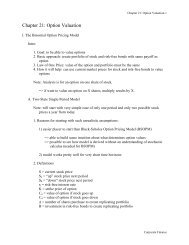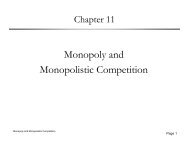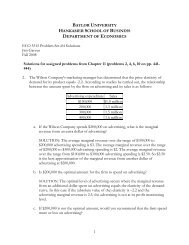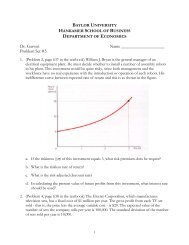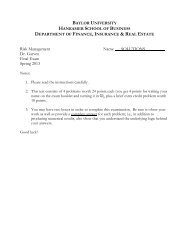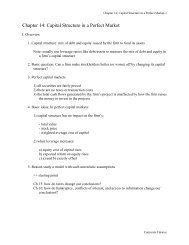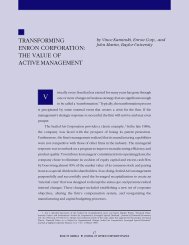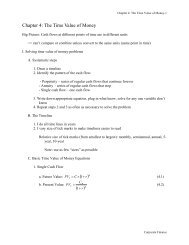Insurance Company Capital Structure Swaps and Shareholder Wealth
Insurance Company Capital Structure Swaps and Shareholder Wealth
Insurance Company Capital Structure Swaps and Shareholder Wealth
Create successful ePaper yourself
Turn your PDF publications into a flip-book with our unique Google optimized e-Paper software.
Substituting for A <strong>and</strong> exp<strong>and</strong>ing the n operator:<br />
∂E<br />
∂α<br />
αδL<br />
= −<br />
αV √ 2tπ ed1V √ t−0.5V 2t −0.5d<br />
e 2 1 − δL<br />
V √ 2tπ e−0.5(d1−V √ t) 2<br />
− αδL [N (d2)]<br />
= − δL<br />
V √ <br />
e<br />
2tπ<br />
−0.5(d1−V √ t) 2<br />
− e −0.5(d1−V √ t) 2<br />
− αδL [N (d2)]<br />
= −αδL [N (d2)] (11)<br />
Thus, as long as liabilities are positive, equity value decreases in proportion to liabilities changed<br />
<strong>and</strong> any deviation between insider <strong>and</strong> market estimates of expected loss.<br />
Two examples follow in which expected managers’ estimates of volatility <strong>and</strong> expected loss<br />
(policy face value) differ from market estimates.<br />
If managers believe that reinsurance will add value for the firm, they may be able to enrich<br />
controlling shareholders by purchasing reinsurance with the proceeds of a new equity issue. How-<br />
ever, a firm can use excess cash to adjust to a desired capital structure without incurring flotation<br />
costs. Alternatively, managers could enrich controlling shareholders by selling more policies, using<br />
the proceeds to reduce outst<strong>and</strong>ing equity <strong>and</strong> thereby increase leverage if they believed that they<br />
could sell policies at a sufficient premium or retire equity at a sufficient discount. Managers need<br />
not retire equity to make such a swap worthwhile if they chose instead to use policy-generated cash<br />
to finance new projects or increase capital levels to satisfy regulators.<br />
Efficient market theory, especially Ross (1977), suggests that announcement of an equity issue or<br />
equity repurchase should signal the manager’s private information to the market <strong>and</strong> prices should<br />
immediately adjust to reflect that new information. However, empirical evidence (See, for example,<br />
Lakonishok <strong>and</strong> Vermaelen (1990); Ikenberry, Lakonishok, <strong>and</strong> Vermaelen (1995); Loughran <strong>and</strong><br />
Ritter (1995); Spiess <strong>and</strong> Affleck-Graves (1995), <strong>and</strong> other literature summarized by Klein, O’Brien,<br />
<strong>and</strong> Peters (2002)) suggest that market responses are not necessarily immediate. With particular<br />
application to insurance companies, Miller <strong>and</strong> Shankar (2005) find that positive excess returns<br />
persist for several months following equity repurchase announcements.<br />
In order to test the impacts of capital structure shifts, we assume that the manager will under-<br />
15



